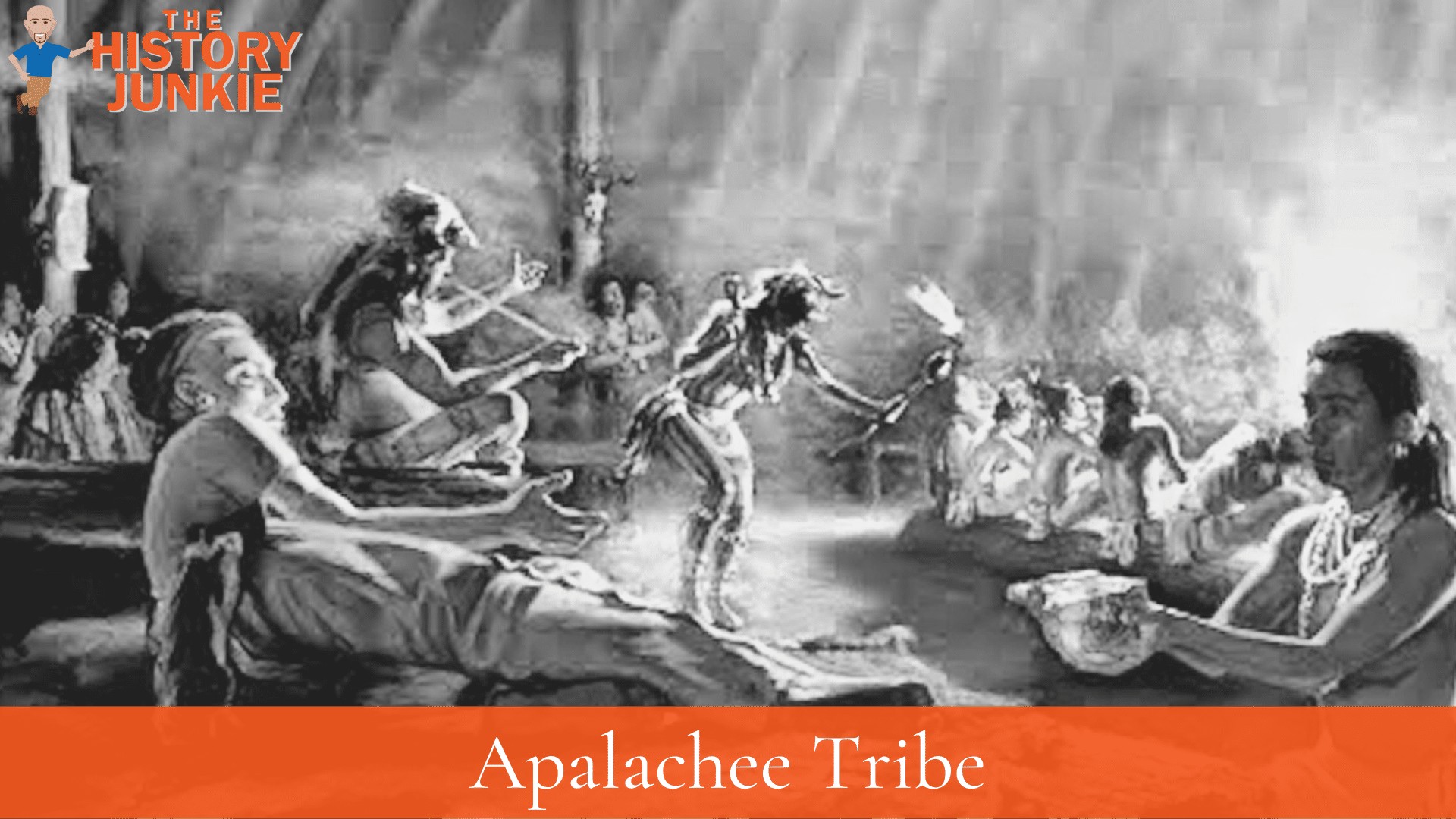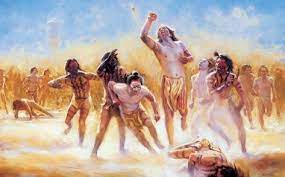The Apalachee Tribe was a Southeast Indian Tribe located in Florida. There were many tribes that lived in Florida. However, this densely populated tribe lived in the Florida panhandle.

At the time of the arrival of the Spanish Conquistadors, the tribe resided between the Aucilla River and the Ochlockonee River
They occupied a site called Velda Mound. The mounds were part of a pre-historic Indian tribe tied into the Mississippian Indian culture.
The Apalachee suffered the same fate as many of the Native Americans. After their initial contact with the Spanish, their population would go into decline due to European disease, European conquest, and wars with other Native American tribes.
This would reduce their population to the point that survivors of the tribe dispersed or merged with other tribes.
History of the Apalachee Tribe
The Apalachee had a relatively dense population and a complex, highly stratified society and regional chiefdom. They were part of the Mississippian culture and an expansive regional trade network reaching the Great Lakes.
Their reputation was such that when tribes in southern Florida first encountered the Pánfilo de Narváez expedition, they said the riches that the Spanish sought could be found in Apalachee country.
The "Appalachian" place name is derived from the Narváez Expedition's encounter in 1528 with the Tocobaga, who spoke of a country named Apalachen far to the north. Several weeks later, the expedition entered the territory of Apalachee north of the Aucilla River.
Eleven years later, the Hernando de Soto expedition reached the main Apalachee town of Anhaica, somewhere in the area of present-day Tallahassee, Florida, probably near Lake Miccosukee (named after the Miccosukee Tribe).
The Spanish subsequently adapted the Native American name as Apalachee and applied it to the coastal region bordering Apalachee Bay, as well as to the tribe that lived in it.
Narváez's expedition first entered Apalachee territory on June 15, 1528. "Appalachian" is the fourth-oldest surviving European place name in the U.S. The name and term Appalachia are also linked to the tribe.
The Yamasee Tribe had links into the mountain South.
It also appears the Apalachee also had such trade and family links farther north, likely linked to Cherokee, Catawba, and other tribes.
Spanish Conquest
After Christopher Columbus discovered a New World, it did not take long for Spain to begin their expansion into the Caribbean, Mexico, and eventually Florida.
Prior to the Spanish conflict with the Apalachee tribe, the Spanish had already changed the political and economic landscape that had been in place for centuries.
Hernan Cortes had defeated the Aztecs, while Francisco Pizarro had defeated the Incas. These tribes were much more powerful than the Southeast Indian Tribes, and with the Spanish thirst for gold and expansion, these tribes would be easy targets.
As noted prior to this, the first contact of the Apalachee tribe was with Panfilio de Narvaez, which occurred in 1528 at a village that the Conquistador believed to be their capital.
After meeting the tribe, Narvaez made plans to defeat and plunder them. His plans would fail as the Apalachee were able to hold them off and then proceed to harass them on the way to the coast by employing impressive guerilla tactics that targeted the Spanish when they were most vulnerable.
The Spanish under Narvaez did manage to build rafts and escape the Apalachee, only to drown or be washed ashore on Galveston Island. While Narvaez would die from drowning, his partner Cabeza de Vaca would begin his epic journey across the southwestern portion of the continent.
A year later, the Apalachee would be forced to defend against a much more prepared and aggressive conquistador named Hernando de Soto.
De Soto did not mince words with the Apalachee and came into their territory aggressively. He quickly took over the town of Anhaica, where he spent the winter.
The Apalachee again showed their keen ability to fight as they organized quick raiding parties and ambushes. They learned that it was more effective to target Spanish horses first. This would neutralize the advantage these animals had on the tribe.
Due to their effectiveness against the Spanish, de Soto was forced to remove himself from their land and explore parts of Georgia.
Despite their victories, the diseases brought by the Spanish began to take effect on the tribe. Their population began to suffer significantly.
Spanish Mission and Indian Attacks
In about 1600, the Spanish Franciscan priests founded a successful mission among the Apalachee, adding several settlements over the next century.
Many Apalachee converted to Catholicism, in the process creating a syncretic fashioning of their traditions and Christianity.
In February 1647, the Apalachee revolted against the Spanish near a mission named San Antonio de Bacuqua in present-day Leon County, Florida.
The revolt changed the relationship between Spanish authorities and the Apalachee. Following the revolt, Apalachee men were forced to work on public projects in St. Augustine (this would include Castillo de San Marcos) or on Spanish-owned ranches.
Starting in the 1670s, tribes to the north and west of Apalachee (including Chiscas, Apalachicolas, Yamasees, and other groups that became known as Creeks) began raiding the Apalachee missions, taking captives who could be traded as slaves to the English in the Province of Carolina.
Seeing that the Spanish could not fully protect them, some Apalachees joined their enemies. Apalachee reprisal raids, made in part to try to capture Carolinian traders, pushed the base camps of the raiders eastward, from which they continued to raid Apalachee missions as well as missions in Timucua Province.
Efforts were also made to establish missions along the Apalachicola River to create a buffer zone. In particular, several missions were established among the Chatot tribe.
In 1702, a few Spanish soldiers and nearly 800 Apalachee, Chatot, and Timucuan warriors, on a reprisal raid after several Apalachee and Timucuan missions had been raided, were ambushed by Apalachicolas.
Only 300 warriors escaped the ambush.
The Demise of the Apalachee
In 1702, the Spanish were not only at war with other tribes but the English. At the end of this war, England would emerge to be stronger than Spain.
However, the war would take a toll on the population of the Apalachee Tribe. Most of the damage to this tribe would not be done by the English but by the other Native Americans who wanted to drive these people out of their land.
In early 1704, Colonel James Moore of Carolina led 50 Englishmen and 1,000 Apalachicolas and other Creeks in an attack on the Apalachee missions. Some villages surrendered without a fight, while others were destroyed.
Moore returned to Carolina with 1,300 Apalachees who had surrendered and another 1,000 taken as slaves. In mid-1704, another large Creek raid captured more missions and large numbers of Apalachees.
In both raids, missionaries and Christian Indians were tortured and murdered, sometimes by skinning them alive. These raids became known as the Apalachee Massacre.
After the war, there were only 800 Apalachees alive. They began to head west but had to endure a yellow fever epidemic near French Louisiana. This again caused their population to decline.
The Apalachee that stayed behind in Florida were eventually displaced after the British took control of Florida in 1763.
Conclusion
The mighty Apalachee tribe managed to fight off two different conquistadors but, in the end, succumbed to disease and their Native American enemies.
The tribe suffered a fate that is rarely spoken of in American History. They were mostly destroyed by other Indian tribes who saw them as vulnerable after the Spanish disease had hurt their population.

Many were killed or sold into slavery to the English due to slavery being lucrative.
Despite this, the memory of this wonderful tribe of Native Americans should be remembered and whose tactics were advanced when considering how well the Spanish Conquistadors fared against the Aztecs and Incas.
What is most remembered of the Apalachee tribe today is not their fierce warriors but a ballgame they played that seems somewhat similar to soccer.
